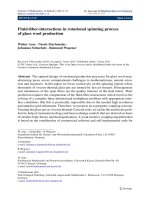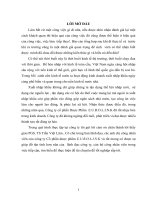alcohols alcohols r o h
Bạn đang xem bản rút gọn của tài liệu. Xem và tải ngay bản đầy đủ của tài liệu tại đây (160.05 KB, 33 trang )
Alcohols R-O-H
Classification CH3, 1o, 2o, 3o
Nomenclature:
Common names: “alkyl alcohol”
IUPAC: parent = longest continuous carbon chain
containing the –OH group.
alkane
drop -e, add –ol
prefix locant for –OH (lower number for OH)
CH3
CH3CHCH2CHCH3
OH
4-methyl-2-pentanol
2o
CH3
CH3CCH3
OH
tert-butyl alcohol
2-methyl-2-propanol
3o
CH3
HO-CHCH2CH3
CH3CH2CH2-OH
sec-butyl alcohol
2-butanol
2o
n-propyl alcohol
1-propanol
1o
Physical properties of alcohols:
polar + hydrogen bonding
relatively higher mp/bp
water insoluble!
(except for alcohols of three carbons or less)
CH3CH2CH2CH2CH2CH2CH2CH2CH2CH2-OH
hydrophobic
hydrophilic
Oldest known organic synthesis:
“fermentation”
Sugar
+ yeast
Grape juice => “wine”
Barley => “beer”
Honey => “mead”
Rice => “sake”
~5-11% ethanol
ethyl alcohol
+ CO2
Distillation of fermented beverages to produce “distilled spirits”
with a greater percentage of ethyl alcohol (bp 78.3 oC).
Ethyl alcohol forms a binary azeotrope with water:
95% ethanol + 5% water (bp 78.15oC)
Diluted with water => “vodka” 40% ethyl alcohol in water.
“proof”: when aqueous alcohol is placed on a sample of
gunpowder and ignited, the gunpowder will burn at a minimum
concentration of 50% alcohol. This is called “100-proof”.
(proof = 2 * alcohol percent)
Add oil of juniper => gin
Add peat smoke => scotch
Age in a burned barrel => whiskey
Add peppermint => schnapps
Etc.
Ethyl alcohol is a poison. LD50 = ~10g/Kg orally in mice.
Nausea, vomiting, flushing, mental excitement or depression,
drowsiness, impaired perception, loss of coordination, stupor,
coma, death may occur. (intoxication)
Alcohols, synthesis:
1.
2.
3.
4. Hydrolysis of alkyl halides (CH3 or 1o)
5.
6.
7.
8.
R-H
R-X
R-OH
Acids
NR
NR
Bases
NR
some
Active
metals
NR
Oxidation
NR
NR
1o/2o
Reduction
NR
NR
Halogens
NR
NR
NR
Alcohols, reactions:
R-|-OH
1. With HX
2. With PX3
3. (later)
RO-|-H
4. As acids
5. Ester formation
6. Oxidation
1. Reaction of alcohols with HX: (#1 synthesis of RX)
R-OH +
a) HX:
HX
R-X +
H2 O
HI > HBr > HCl
b) ROH: 3o > 2o > CH3 > 1o
c) May be acid catalyzed
d) Rearrangements are possible except with most 1o alcohols.
CH3CH2CH2CH2-OH
+
NaBr, H2SO4, heat
CH3CH2CH2CH2-Br
n-butyl alcohol
n-butyl bromide
1-butanol
1-bromobutane
CH3
CH3C-OH
CH3
+
HCl
CH3
CH3C-Cl
CH3
(room temperature)
tert-butyl alcohol
tert-butyl chloride
2-methyl-2-propanol
2-chloro-2-methylpropane
CH3CH2-OH
+
HI, H+, heat
CH3CH2-I
ethyl alcohol
ethyl iodide
ethanol
iodoethane
Mechanism?
CH3-OH and most 1o alcohols react with HX via SN2 mechanism
3o and 2o react with HX via SN1 mechanism
Both mechanisms include an additional, first step, protonation
of the alcohol oxygen:
R-OH + H+
R-OH2+
“oxonium ion”
Whenever an oxygen containing
compound is placed into an acidic
solution, the oxygen will be
protonated, forming an oxonium ion.
Mechanism for reaction of an alcohol with HX:
CH3OH or 1o alcohols:
SN2
1)
2)
R-OH
X
+
+
R-OH2
HX
R-OH2
RDS
R-X
+
+
X
H2O
Mechanism for reaction of an alcohol with HX:
2o or 3o alcohols:
SN1
1)
R-OH
2)
R-OH2
3)
R
+
+
HX
RDS
X
R-OH2
R
R-X
+
H2O
+
X
May be catalyzed by acid.
SN2 rate = k [ ROH2+ ] [ X- ]
SN1 rate = k [ ROH2+ ]
Acid protonates the -OH, converting it into a better leaving
group (H2O), increasing the concentration of the oxonium ion,
and increasing the rate of the reaction.
Rearrangements are possible (except with most 1o alcohols):
CH3
CH3CHCHCH3 + HBr
OH
Br
↑
CH3
CH3CHCHCH3
OH2+
CH3
CH3CCH2CH3
Br-
CH3
[1,2-H]
CH3
CH3CHCHCH3 CH3CCH2CH3
+
+
2o carbocation
3o carbocation
In the reaction of most 1o alcohols with HX you don't have
to worry about the possibility of rearrangements. The mechanism
is SN2 and does not involve carbocations.
CH3CH2CH2CH2CH2-OH +
HBr, H+, heat
1-pentanol
CH3CH2CH2CH2CH2-Br
1o alcohol:
No rearrangement, SN2
1-bromopentane
Most 1o? If large steric requirement…
CH3
CH3CCH2-OH
+
CH3
neopentyl alcohol
HBr
CH3
CH3CCH2CH3
Br
2-bromo-2-methylbutane
CH3
CH3CCH2-OH2+
CH3
CH3
CH3CCH2+
CH3
1o carbocation
CH3
CH3CCH2CH3
+
3o carbocation
[1,2-CH3]
2. With PX3
ROH +
PX3
RX
a) PX3 = PCl3, PBr3, P + I2
b) No rearrangements
c) ROH: CH3 > 1o > 2o
CH3
CH3CCH2-OH
CH3
neopentyl alcohol
+
PBr3
CH3
CH3CCH2-Br
CH3
2,2-dimethyl-1-bromopropane
3. Dehydration
(later)
4) As acids.
a) With active metals:
ROH +
Na
RONa
+
½ H2
b) With bases:
ROH +
NaOH
NR!
CH4 < NH3 < ROH < H2O < HF
CH3CH2OH
+
WA
+
SB
+
NaNH2
SB
+
CH3CH2ONa
SA
CH3MgBr
SA
SA
H2O
WB
CH3CH2OH
CH3OH
NaOH
SB
CH4
+
MgBr(OCH2CH3)
WA
NH3
WA
+
WB
CH3ONa
WB
5. Ester formation.
CH3CH2-OH
+
CH3CO2H, H+
CH3CH2-OH
+
CH3COCl
CH3-OH
CH3SO2Cl
+
Esters are alkyl “salts” of acids.
CH3CO2CH2CH3
CH3CO2CH2CH3
CH3SO3CH3
+
HCl
+
+
H2 O
HCl
O
R C
OH
O
R C
ONa
O
R C
OR'
ester
carboxylic acid
sodium salt
O
R S OH
O
O
R S OK
O
sulfonic acid
potassium salt
O
HO P OH
OH
O
HO P OR
OH
O
HO P OR
OR
monoester
diester
phosphoric acid
O
R S OR'
O
ester
O
RO P OR
OR
triester









